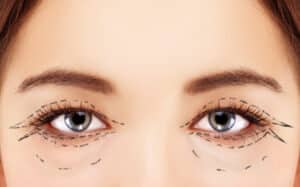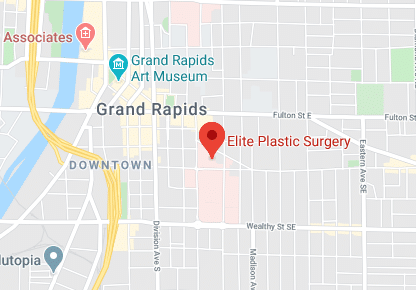
The skin around the eyes is delicate and especially vulnerable to the effects of aging. Over time, not only do the eyelids stretch, but the muscles supporting them also weaken, both contributing to the saggy appearance. In addition, excess fat often gathers above and below the eye, causing puffiness, droopy upper lids and bags under the eyes. Fortunately, eyelid surgery is a highly effective cosmetic procedure offered at Elite Plastic Surgery to correct these issues.
What is Eyelid Surgery?
Eyelid surgery (blepharoplasty) is surgery to improve the appearance of droopy, sagging eyelids and/or remove under-eye bags. It can involve removing excess skin, muscle, and fat from the upper eyelids, lower eyelids or both.
An upper blepharoplasty can reduce or eliminate vision problems by removing saggy skin and at the same time, make the eyes appear younger and more alert. A lower blepharoplasty can remove excess skin and fat deposits, as well as tighten the areas around the eyes and improve overall appearance.
Candidates For Blepharoplasty
Those individuals most suitable for eyelid surgery are in good health and have realistic expectations about results. Patients seeking this surgery want to achieve tighter, more youthful eyelid contour by eliminating such features as:
- Excess lower eyelid skin and/or upper eyelid skin that may be interfering with peripheral vision
- Droopy lower eyelids that may also be causing the whites of the eyes to show below the iris
- Under eye bags
Types of Eyelid Surgery
Upper Blepharoplasty
- Performed to remove excess skin and fat around the upper eyelid
- Can also improve vision and reduce headaches caused by straining to see past sagging skin.
Lower Blepharoplasty
- Performed to remove excess skin, reduce wrinkles and improve the contour of the lower eyelid by removing skin and fat.
- Can also include tightening the eyelid to further correct droopiness or sagging.
- Can also include adding fat to improve hollow-eye appearance.
Double Upper Blepharoplasty
- Also called Asian or Westernization eyelid surgery, performed to create an upper eyelid crease.
Eyelid Surgery Procedure
Your surgeon injects numbing medication around the eyelids and administers intravenous medication for relaxation and pain numbing. Blepharoplasty usually takes less than two hours, depending on the amount and location of tissue being removed. It is commonly an outpatient procedure with most people going home the same day as the surgery.
- For the upper lids – The surgeon cuts along the fold of the eyelid to remove excess skin, muscle and fat and then closes the incision.
- For the lower lids – The surgeon makes a cut just below the lashes in your eye’s natural crease or inside the lower lid. Excess fat is removed or redistributed, sagging skin is removed, the area is tightened and the incision is closed.
Blepharoplasty Results
Most patients notice they have a more rested and youthful appearance (and more self-confidence), a month or two after surgery. Scars from the surgical incisions may take up to six months or longer to fade.
Are My Eyelid Surgery Results Permanent?
Over time, the skin and supporting muscles will continue to lose firmness. While the eyelids should never return to their pre-blepharoplasty condition, aging will have some effect. Many people are pleased with the results of the surgery throughout their lifetimes, especially the removal of under eye bags. Some patients choose to have additional surgery later in life to better keep up with the results of aging.
Eyelid Surgery Before & After Photos
*Individual results may vary
Click to view more Eyelid Surgery before and after photos>>
Blepharoplasty Recovery
After surgery, you will spend some time recovering on-site and being monitored for complications. Most patients leave later in the day to recuperate at home and the overall recovery period is fairly short. Bruising and swelling may be worse the day after surgery, but should disappear quickly.
During the first 48 hours
- Patients should use cool compresses to reduce bruising and swelling
- Light activity should resume to help speed healing, such as walking
- Any bandages can usually be removed, and if stitches aren’t self-absorbing, they will be moved in about a week.
At one to two weeks
Most people return to normal activities 7-10 days following blepharoplasty. Two weeks post-surgery, the majority of bruising and swelling should resolve.
What Other Procedures Can Be Combined with Blepharoplasty?
The surgery can be performed on the upper or lower eyelids, or both, and can also be done in conjunction with other related surgery procedures, such as a facelift or brow lift.
Side Effects Of Eyelid Surgery
Some possible temporary side effects include:
- Moderate pain
- Sensitivity to light
- Double vision
- Watery eyes
- Puffy, numb eyelids
- Swelling and bruising
Blepharoplasty Risks
Blepharoplasty is a fairly simple, quite safe procedure. All surgery comes with the risks associated with surgery in general, including reaction to anesthesia and rarely, blood clots and cardiac and pulmonary complications. Eyelid surgery specifically can cause:
- Infection and bleeding
- Dryness and irritation
- Difficulty closing eyes
- Obvious scarring
- Injury to eye muscles
- Skin discoloration
- Temporary blurred vision
- Loss of eyesight, quite rarely
- The need for follow-up surgery
Will Blepharoplasty Change the Shape of My Eyes?
Because the blepharoplasty procedure works by trimming away excess skin and superficial tissue, it’s common to wonder if eye shape will be altered. Your experienced plastic surgeon will perform your eyelid procedure with a meticulous technique that should avoid major changes in the shape of your eyes. What you can expect after blepharoplasty is to have eyes that look bigger. This is the result of the removal of bulky, saggy tissue from the upper or lower eyelids.
What Causes Droopy Eyelids?
It’s important to understand why your eyelids have become droopy as you seek to correct the issue through plastic surgery. The right procedure is selected based on the cause of the sagging that has occurred. Some of the common reasons for droopy eyelids include:
- Ptosis. This type of eyelid drooping is not related to aging, nor to fatty tissue. Ptosis occurs when the tendon that attaches the eyelid to the muscle that raises it has become weak or has detached. This condition must be corrected by reattaching the tendon to the muscle or by shortening the muscle. Ptosis repair can be combined with blepharoplasty or performed on its own.
- Dermatochalasis. This sophisticated word is the clinical term for excess skin. It’s a result of the aging process and the decline in collagen and elastin in the delicate tissue around the eyes. As the tissue becomes thinner and looser, it sags and droops on both the upper and lower eyelids.
- Fat. The eyelids have a small amount of fatty tissue that keeps the eyes from appearing sunken. As the muscle and skin around the eyes loosen with age, there is the potential for fatty prolapse. This means that the fat pads around the eyes, usually on the lower eyelids, aren’t secured as well as they once were. They bulge, creating the appearance of undereye bags or hooding.
- Brow ptosis. Hooding of the upper eyelids may have nothing to do with the eyelids at all. Sometimes, its the descent of the eyebrows, caused by loose skin and contracted muscles, that press down on the upper eyelid tissue. Your surgeon will help determine if this is the case and will recommend treatment accordingly.
Will I Look Dramatically Different After Blepharoplasty?
You will look younger after having blepharoplasty but you will still look like yourself. Blepharoplasty won’t alter your facial expression or appearance in a massive way. In fact, many people you know may not notice that you’ve had surgery; they’ll only notice that you look refreshed and, somehow, a bit younger and more energetic!
What is the Best Age to Have Blepharoplasty Surgery?
There is no perfect age at which blepharoplasty will achieve the best results. Nearly all eyelid rejuvenation procedures are performed on patients over the age of 40, with many of them over the age of 55. That said, some people seek blepharoplasty at an earlier age to correct naturally heavy eyelids. When considering whether or not you’re a good candidate for blepharoplasty, your surgeon will be much more interested in your goals and overall health than your age.
Why Choose Elite Plastic Surgery for Eyelid Surgery
Elite Plastic Surgery in Grand Rapids offers exceptional patient care and advanced surgical expertise. Our reputable, board-certified plastic surgeons, Dr. Shannon Armstrong, Dr. William Cullen, Dr. Matthew Fahrenkopf, and Dr. Matthew Martin, bring to the practice a combined 40 years of experience performing cosmetic procedures, including eyelid surgery.
Focusing on individualized care, patient education, and communication, they ensure you receive tailored treatments in a compassionate environment. Their commitment to the latest surgical techniques and personalized results makes Elite Plastic Surgery a trusted choice for your eyelid surgery needs.
Frequently Asked Questions (FAQs)
How long does it take to see results from eyelid surgery?
You’ll begin to notice the results of your eyelid surgery within a few weeks as swelling and bruising subside. However, your final results may take several months to fully appear once your eyes heal completely and the tissues settle.
Will I have visible scars after eyelid surgery?
The incisions for eyelid surgery are typically made along the natural creases of the lids or inside the lower eyelid, making scars well-hidden and minimally visible. Over time, any scars will fade significantly and become nearly invisible.
How long do eyelid surgery results last?
The results can last for many years. While the procedure effectively addresses sagging skin and puffiness, the natural aging process will continue. Most patients enjoy their results for 10-15 years or more before considering any additional treatments.
What should I do to prepare for eyelid surgery?
- Avoid smoking and alcohol for several weeks before surgery.
- Stop taking blood-thinning medications and supplements as directed by your surgeon.
- Arrange for someone to bring you home and assist you during the first few days of recovery.
- Ensure you have ice packs, gauze, and prescribed medications ready for post-operative care.
- Follow any specific instructions given to you by your surgeon regarding pre-surgical care.
How can I enhance and prolong the results of eyelid surgery?
- Use sunscreen regularly to protect the delicate skin around your eyes.
- Maintain a healthy lifestyle—stay hydrated and stick with a balanced diet.
- Consider non-invasive treatments, such as BOTOX or dermal fillers, to maintain a youthful appearance.
- Follow your surgeon’s post-operative care instructions to promote healing.
- Avoid smoking, as it accelerates skin aging and can negatively impact results.
Does insurance cover eyelid surgery?
Eyelid surgery might be covered by insurance if performed to correct functional issues, such as vision impairment caused by drooping eyelids. However, if the surgery is purely cosmetic, it is typically not covered by insurance. Your surgeon’s office can help you determine if your specific case qualifies for insurance coverage. Also, look into financing options.
Schedule A Consultation
According to statistics from the American Society of Plastic Surgeons, eyelid surgery is one of the top five most popular cosmetic procedures. To help decide if the surgery is right for you, schedule a consultation with us. Call our Grand Rapids office at (616) 459-1907
Together we explore realistic outcomes, benefits and risks of the procedure. Elite Plastic Surgery proudly serves Grand Rapids MI and surrounding areas.




